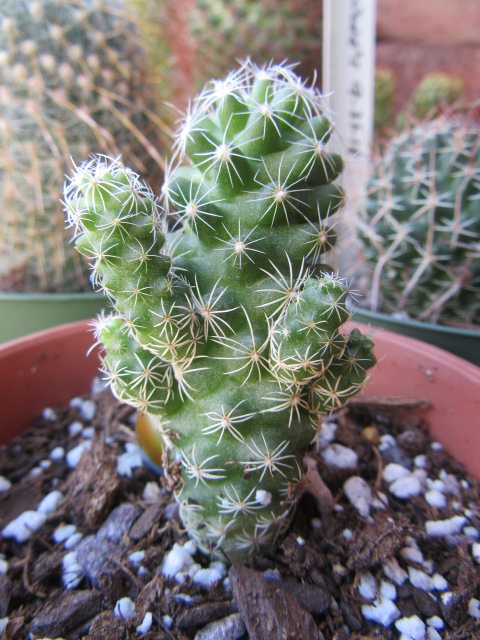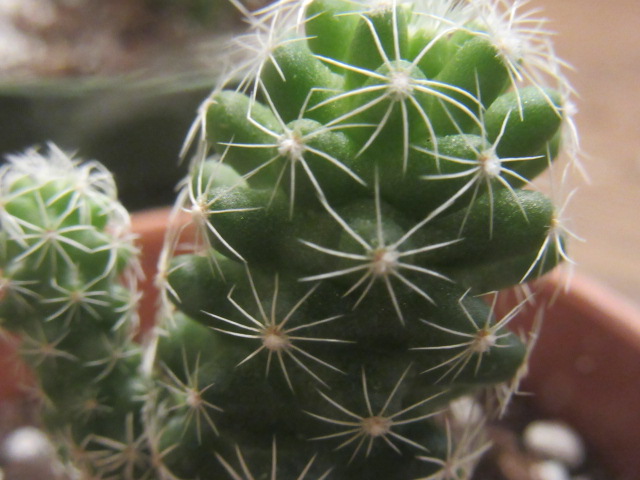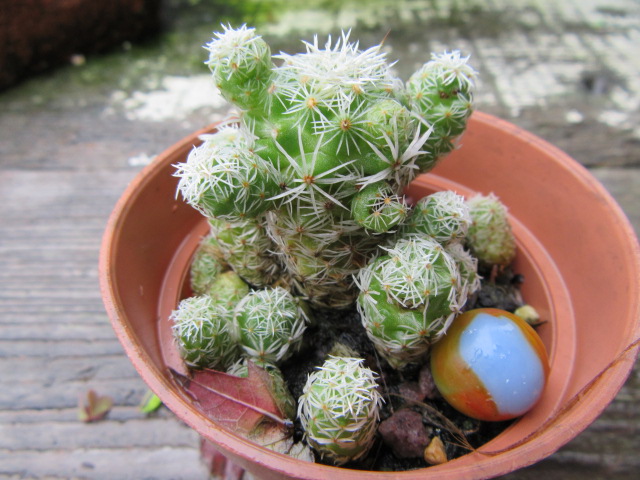
Mammillaria vetula (syn. subsp. gracilis) (Thimble Cactus) after I brought it home on 4-20-13, #144-7.
Thimble Cactus
Mammillaria vetula subsp. gracilis
mam-mil-AR-ee-uh VET-uh-luh GRASS-il-is
SYN. OF:
Mammillaria vetula
Commonly sold as:
Mammillaria gracilis var. fragilis
mam-mil-AR-ee-uh GRASS-il-is FRAJ-ih-liss
Synonyms of Mammillaria vetula (24) (Updated on 12-8-23 from Plants of the World Online): Cactus gracilis (Pfeiff.) Kuntze, Cactus pulchellus (Salm-Dyck) Kuntze, Cactus regius (C.Ehrenb.) Kuntze, Cactus vetulus (Mart.) Kuntze, Chilita fragilis (Salm-Dyck ex K.Brandegee) Orcutt, Chilita vetula (Mart.) Orcutt, Escobariopsis gracilis (Pfeiff.) Doweld, Escobariopsis vetula (Mart.) Doweld, Krainzia gracilis (Pfeiff.) Doweld, Mammillaria fragilis Salm-Dyck ex K.Brandegee, Mammillaria gracilis Pfeiff., Mammillaria gracilis var. fragilis A.Berger, Mammillaria gracilis var. pulchella (Salm-Dyck) Salm-Dyck, Mammillaria gracilis f. pulchella (Salm-Dyck) Schelle, Mammillaria grandiflora Salm-Dyck, Mammillaria kuentziana P.Fearn & B.Fearn, Mammillaria magneticola J.Meyrán, Mammillaria pulchella Salm-Dyck, Mammillaria regia C.Ehrenb., Mammillaria vetula subsp. gracilis (Pfeiff.) D.R.Hunt, Mammillaria vetula subsp. lacostei Plein & Heinr.Weber, Mammillaria vetula subsp. magneticola (J.Meyrán) U.Guzmán, Neomammillaria fragilis (Salm-Dyck ex K.Brandegee) Britton & Rose, Neomammillaria vetula (Mart.) Britton & Rose
***Although there are differences, Plants of the World Online by Kew lists Mammillaria vetula subsp. gracilis as a synonym of Mammillaria vetula. According to descriptions, Mammillaria vetula has 1-2 central spines and 25 radial spines where Mammillaria vetula subsp. gracilis has NO central spines. My plants have no central spines.
Mammillaria vetula Mart. is the accepted scientific name. It was named and described as such by Carl (Karl) Friedrich Philipp von Martius in Nova Acta Physico in 1832.
Mammillaria vetula subsp. gracilis (Pfeiff.) D.R.Hunt is now considered a synonym of Mammillaria vetula. This subspecies was named and described as such by David Richard Hunt in Mammillaria Postscripts in 1997. It was first named Mammillaria gracilis Pfeiff. by Ludwig Karl Georg Pfeiffer in Gartenzeitung in 1838.
Mammillaria gracilis var. fragilis A.Berger was named and described by Alwin Berger in Kakteen in 1929. This name is what the industry is commonly using…
The genus, Mammillaria Haw., was named and described by Adrian Hardy Haworth in Synopsis Plantarum Succulentarum in 1812.
As of 12-8-23 when this page was last updated, Plants of the World Online by Kew lists 139 accepted species in the Mammillaria genus. It is a member of the plant family Cactaceae with 150 genera. These numbers could change as updates are made on POWO.
THERE ARE SEVERAL LINKS AND GROWING RECOMMENDATIONS AT THE BOTTOM OF THE PAGE FOR FURTHER READING.

Mammillaria vetula (syn. subsp. gracilis) on 6-1-13, #151-52.
I brought my first Mammillaria vetula subsp. gracilis home from Lowe’s on April 20 in 2018. This was my first Mammillaria so I was anxious to see how we got along. When temps warmed up enough I moved this cactus outside with the rest of the plants then I put it in a larger pot.

Mammillaria vetula (syn. subsp. gracilis) on 7-30-13, 165-43.
The species, Mammillaria vetula and subspecies Mammillaria vetula subsp. gracilis are native in the states of Hidalgo, Guanajuato, and Querétaro in Mexico where they are found in pine forests at high altitudes.
Mammillaria vetula and the subspecies are small, freely clustering plants that can grow 4-5″ tall x about 1 1/2″ in diameter… Not sure how long that takes because none of mine ever grew that big. Supposedly, the offsets of the species are not as bad about falling off as the subspecies.
Their tubercles are round, bluntly conical and the areoles have a small tuft of wool. The axils between the tubercles on the subspecies and cultivar are bare while the species may be slightly wooly and bristly (hairs).
The areoles on top of the tubercles of the species produce 25 or so (up to 50 on mature specimens) white radial spines while the subspecies have 11-16. The radial spines on ‘Arizona Snowcap’ are shorter, thicker, and very dense. The species generally have 1-2 reddish-brown central spines that are longer than the radials. The subspecies and cultivars “usually” have no central spines.

Mammillaria vetula (syn. subsp. gracilis) on 8-23-13, #178-62.
The Thimble Cactus is a very easy plant to grow if you follow a few simple rules. They don’t mind regular watering during the summer months, but too much water in the winter is NOT a good idea. I just water my cactus maybe once or twice during the winter if at all. When I water my cactus and succulents during the summer, I just go over them with the wand one time. The other plant’s pots get filled to the rim.

Mammillaria vetula (syn. subsp. gracilis) on 9-17-13, #188-44.
Information online says that this plant does well in full sun to part shade. When you move your plants outside for the summer, they need to get used to more light gradually. I normally place mine in light to part shade at first then gradually slide them over on the table to get more light. If they show any sign of sunburn, I put them back in more shade. I think I kept this cactus on the table behind the shed in more shade all summer.

Mammillaria vetula ( syn. subsp. gracilis) from the top on 9-30-13, #192-6.
Once in a while, I noticed one of the offsets had fallen off the table. I just put it back in the pot where it can take root. That is actually how they spread in the wild.
<<<<2014>>>>

Mammillaria vetula (syn. subsp. gracilis) on 6-1-14, #228-59.
We made it through the 2013-2014 winter just fine and it was glad to be back outside again.

Mammillaria vetula (syn. subsp. gracilis) on 7-12-14, #231-70.
I really enjoyed this plant as a companion, but unfortunately, I gave up most of my plants after the above photo was taken. I started recollecting plants again later in 2015.
<<<<2018>>>>

Mammillaria vetula (syn. subsp. gracilis) on 9-13-18, #507-22.
I found this cactus at Wagler’s Greenhouse when I took plants there in September. It was unlabeled but I was sure it was a Mammillaria. I wasn’t sure what species it was at first because I was used to seeing them sold in clusters and not as a single specimen.

Mammillaria vetula (syn. subsp. gracilis) on 10-10-18, #519-53.
I had to move the potted plants inside for the winter on October 10 because the forecast was calling for an “F” in a few days and the nighttime temperatures were getting cooler. I usually measure the cactus and succulents when I bring them inside. This plant measured 2 1/4″ tall.

Mammillaria vetula (syn. subsp. gracilis) on 11-29-18, #534-30.
November 29 was a nice spring-like day, so I took the cactus to the back porch for a photoshoot. I was working on a post to show the difference between the cactus in my collection.

Mammillaria vetula (syn. subsp. gracilis) close-up on 12-1-18, #535-22.
The species, Mammillaria vetula, has 1-2 central spines and at least 25 radial spines. The subspecies often lack the central spines and only have 11-16 radial spines.
<<<<2019>>>>

Mammillaria vetula (syn. subsp. gracilis) on 6-22-19, #593-36.
The potted plants made it through the winter and once evening temperatures warmed up I moved the potted plants back outside for the summer. I moved the cactus to the back porch where they could receive full sun. The Mammillaria vetula subsp. gracilis had grown lots of offsets.
I was fairly busy during the summer so I didn’t take many photos. All the plants did very well despite a little neglect.

Mammillaria vetula (syn. subsp. gracilis) on 10-13-19, #641-4.
I had to bring the potted plants inside on October 11 because an “F” was in the forecast. I always take photos of the plants as I bring them inside and measure the cactus and some of the succulents but I forgot to photograph this one so I did it on the 13th. It measures 2″ tall and most of its offsets have fallen off.

Mammillaria vetula (syn. subsp. gracilis) with a bud on 11-23-19, #655-5.
I was surprised to see a couple of buds on this cactus on 11-23-19.

Mammillaria vetula (syn. subsp. gracilis) flower on 11-30-19, #657-4.
This particular cactus will be interesting to watch grow because it started out as a single plant and I will get to watch it multiply. I just have to keep an eye on the offsets when they fall off to make sure they don’t blow away or fall off on the ground during the summer.
<<<<2020>>>>

Mammillaria vetula (syn. subsp. gracilis) at 1 3/8″ tall on 10-15-20, #747-82.
I had to move the potted plants inside for the winter on October 15 because an “F” was in the forecast. As always, I took photographs and measurements as I brought them inside. The Mammillaria vetula subsp. gracilis did very well over the summer and measured 1 3/8″tall when I brought the plants inside. It has several kids still attached although many have fallen into the pot… I have to always make sure they are sitting upright.

Mammillaria vetula (syn. subsp. gracilis) with a flower and several buds on 11-6-20, #755-6.
I took a few more photos of some of the Mammillaria flowering in my small collection on 11-6-20 for a new post. It’s always funny to see this plant flowering when it is so small.
<<<<2021>>>>

Mammillaria vetula (syn. subsp. gracilis) (Thimble Cactus) at 1 7/8″ tall on 10-28-21, #853-25.
The original stem continued growing taller and was 1 7/8″ tall when the above photo was taken. It was a little wet because we had rain. The offsets that grew on the main stem are still attached from last year. Before that, most of them fell off. I should take a photo from the top…
<<<<2022>>>>
Well, I lost several cacti over the summer of 2022 and this was one of them. This species is easy to find, so I will bring home another one. They are great plants and fun to watch grow and multiply.
USEFUL INFORMATION:
Family: Cactaceae
Origin: Mexico
Zones: USDA Zones 9a-11 (20 to° F)
Size: 6” or so tall
Light: Sun to part shade
Soil: Fast-draining. Good quality potting soil amended pumice (50/50 or additional perlite and chicken grit (2-1-1).
Water: Average during the growing period, barely in winter.
Flowers: Pale to bright yellow
You can read my Cactus Talk & Update and Cactus & Succulent Tips to get my opinion about growing cactus and succulents.
When you bring your new plants home from the store, you need to check their roots and the soil to see if they are wet. If so, you may want to re-pot it right away. It is advisable to re-pot them in a better potting soil more suitable for cactus and succulents.
I enjoy growing cacti and succulents and the Mammillaria vetula subsp. gracilis is no exception. You just have to keep an eye on it and make sure when the offsets fall off they don’t roll out of the pot. Make sure the “fall-offs” are sitting bottom side down so they will take root.
I hope you enjoyed this page and maybe found it useful. I would like to hear from you if you have any comments, questions, or suggestions. Please click on “like” if you visited this page. It helps us bloggers stay motivated. 🙂 You can check out the links below for further reading. They take you directly to information about the species.
I was gifted two cacti plants which looks like the mammillaria cactus it they resemble the thimble plant but the one has longish strands of hair
LikeLiked by 1 person
Hello, Marlene! Glad to hear from you! Hard to tell what species they are unless the person who gave them to you knew. I use several Facebook groups to help identify cacti when I don’t know. Try the group Succulent Infatuation or a Mammillaria group. They are very helpful. You can send photos to me at thebelmontrooster@yahoo.com if you want and I’ll see if I can help. Take care and thanks for stopping by!
LikeLike